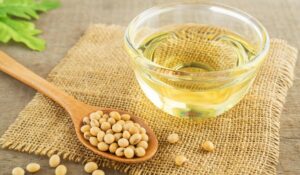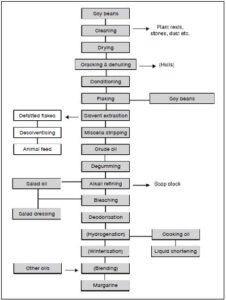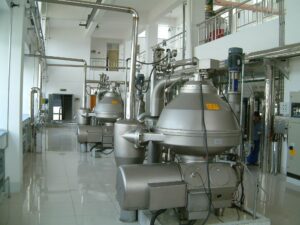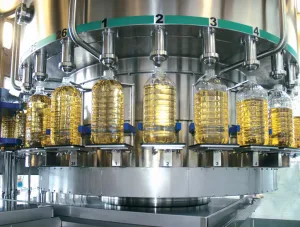Soy bean oil
When soy beans were first processed commercially, the oil was considered as the most valuable component and the defatted soy bean flour as a by-product. But since 1960, the need for alternative protein sources has risen sharply across the globe. Today the flour is a highly sought after component of animal feed. One tonne of soy beans yield approximately 183 kg of oil and approximately 800 kg of flour.
The production of soy bean oil has increased dramatically and is currently considered one of the major food oils in the world. This is largely due to an improved understanding of lipid chemistry and enhanced oil processing technology. Modern soy oil is a stable, high quality triglyceride ingredient and is used widely in commercial processed foods. The crude soy oil contains both oil soluble and water soluble impurities that need to be removed by a series of refining operations.

Soy bean oil (Image source: onlyfoods.net)
The process description of soy bean oil
Cleaning of soy beans
The first step in preparing the soy beans for oil extraction is to remove foreign materials, including plant rests, stones and dust. Cleaning is performed by a series of vibrating screens followed by aspirators and cyclone separators.
Drying of soy beans
Drying prior to dehulling is necessary to reduce the moisture content of the soy beans. A moisture content of 10% is needed to remove the hull effectively. Drying is performed by heated air that is distributed through a bed/layer of soy beans, followed by cooler air, which removes the residual moisture laden air.
The dried soy beans are placed in tempering bins where the moisture is allowed to equilibrate throughout the beans for one to five days.
Cracking and dehulling of soy beans
The objective of cracking is to break the soybeans into small pieces to achieve dehulling and to ease flaking. Corrugated or fluted rollers that rotate in opposite directions and at different speeds are used to crack soy beans. Cracking rollers are generally 25 cm in diameter and at least 107 cm in length. Cracking reduces the whole soy bean into four to six fragments, loose hulls and some fines (flour particles). The fragments are sized on vibrating screens. Whole beans and large fragments are returned to the cracking rollers.
The soy bean fragments (cotyledon) contain about 20% oil while the hull has a negligible oil content. The removal of the hulls by aspiration is optional but has the advantage of producing a defatted soy meal with a higher protein content (48% as opposed to 44% protein of flour containing hulls).
Conditioning of soy beans
The cracked soy beans (soy meats) are then conditioned with heat and moisture to obtain the optimum plasticity necessary for soy flake production. This is achieved by steam heating that raises the moisture content to 11% and the product temperature to 65 to 70° C. Typical steam heaters used include vertically stacked and horizontal rotary heat exchangers. Alternatively, fluidised bed heating can be used.
Flaking of soy beans
Flaking is necessary prior to oil extraction to reduce the particle size and increase the surface area from which the oil can be extracted. Soy flakes are approximately 0,25 to 0,37 cm thick. Flaking rollers are horizontal, smooth rolls whose pressure is maintained by springs under hydraulic pressure. It is important to ensure that the soy pieces are evenly fed over the entire surface of the flaking rollers to maintain uniform flake production.

The process description of soy bean oil (Optional process or ingredient).
Oil extraction from soy flakes
Soy oil can be extracted by one of two methods, solvent extraction or mechanical extraction. Solvent extraction is used by most commercial oil extraction plants while mechanical extraction is often preferred by small extraction plants, particularly where a variety of oilseeds are processed.
Solvent extraction of soy oil
Solvent extraction entails removing the oil from the flakes by an organic solvent to form an oil/solvent mixture known as miscella. The oil is recovered from the miscella by a distillation process. The most widely used solvent is hexane. It is not the perfect solvent, but fulfils most of the extractor’s requirements. Several types of solvent extractors are available. Commercial extraction is performed by continuous, counter-current systems such as the “Rotocel” (deep bed extractor) and “Loop extractor” (shallow bed extractor). Fresh solvent is introduced at the end of the line to defatted flakes. At the end of the extraction process the defatted flakes are dumped into a discharge chamber from where it is transferred to a desolventising toaster. The miscella containing the oil is diverged to the solvent stripping area.
Miscella stripping
The oil-hexane mixture (miscella) consists of 70 to 75% oil and 25 to 30% hexane. The hexane must be recycled for re-use to make the process more economical and the oil must be made safe for consumption. This requires the hexane to be separated from the oil by an evaporation process. A two-stage stripping evaporator and stripping column is used. The shell-in-tube type of evaporators is used with miscella entering at the bottom of the tubes and hexane fumes collecting at the vapour dome at the top. The crude soy oil should be cooled to 40° C prior to storage. It is not only the oil that needs to be stripped of hexane. The defatted flakes (oil-cake) also need to be desolventised.
Desolventising soy meal
The defatted flakes contain about 30% hexane by weight. The hexane needs to be removed to make the soy meal safe for use as animal feed. This is achieved by steam (heat and moisture) is a special desolventising toaster. The heat treatment not only vaporises the hexane, but also improves the nutritional quality of the soymeal by inactivating the trypsin inhibitors and other naturally occurring toxicants.
Storage of crude soy oil (storage)
Crude soy oil can be stored for short periods prior to refining, but keep in mind that impurities affect the storage stability of the oil. Storage stability can be improved by the removal of fines by filtration through a fine mesh screen.

Refining of soy bean oil (Image source: oilmachinedy.com)
The USA trading specifications for prime crude soy oil are as follows:
- Moisture content <0,5%
- Neutral oil loss 7,5%
- Unsaponifiables 1,5%
- Flashpoint 121° C
Mechanical oil extraction (optional)
The alternative to solvent extraction is mechanical extraction of oil. Soy oil is extracted mechanically by passing the soy flakes through a screw press. The screw press consists of a shaft with an interrupted worm gear that rotates in a cage of metal bars with small spaces between them. The high pressure that is generated inside the press forces the oil out the flakes and through the cage bars. The pressed cake moves along the shaft and is expelled at the end. The resulting soy meal has a higher oil content, thus oil yield is lower compared to solvent extraction. Advantages include lower initial costs, no solvent requirement and no need for solvent recovery systems.

Bottling of soybean oil for cooking purposes (Image source: bridgat.com)
Oil refining
Crude oil contains a wide variety of impurities, including seed fragments, excess moisture, waxes, gums, free fatty acids, colour pigments, sterols, hydrocarbons, ketones and aldehydes. The refining process consists of four to six steps to remove most of these impurities. Each step is designed to remove selected components from the oil. These refining steps include degumming, alkali refining, bleaching, deodorisation, hydrogenation and winterisation. These refining steps, with the exception of degumming, are usually performed at a different location, and not at the extraction facility.
Degumming
Degumming is the removal of phospholipids, also referred to as lecithin. Phospholipids must be removed to avoid browning of the oil and off-flavour formation occurring during the deodorisation process and to prevent oxidation during physical refining. Lecithin is also extracted because it is a very useful food additive.
Degumming involves mixing soft, warm water (1 to 3%) with heated oil (both at 70° C). The water attracts the polar phospholipids, which are partitioned into the water phase. The high temperature of the oil and water prevents emulsion formation. The oil and water phases are then separated by centrifugation.
Neutralisation
Neutralisation is the removal of free fatty acids from the oil. It is necessary to reduce them as they reduce the smoke point of the oil and increase foaming. Several neutralisation methods are used in the industry, but alkali refining is most commonly used. It can be performed on crude or degummed oil. The soy oil is pre-treated with phosphoric acid prior to alkali refining.
Free fatty acids are then removed by the addition of alkali (sodium hydroxide) to the oil. The reaction that takes place leads to the formation of sodium salts, that is soaps that are subsequently removed by centrifugation. After centrifugation, the oil still contains traces of soaps, which are removed by washing in hot water (94° C. The oil is once more centrifuged, and then vacuum dried for storage prior to further processing. Oil at this stage of processing is often referred to as once refined oil.
The by-product (soap stock) produced by this process, can be used by soap manufacturers.
Bleaching
Bleaching is an adsorption process whereby minor oil components are bound by a fine, powdered adsorbent (bleaching earth). It is performed at high temperatures (slightly above 100° C) and under vacuum. The process is important in enhancing oil appearance, flavour, and stability.
Deodorisation
Deodorisation is a steam stripping process that aims to vaporise undesirable volatile components. It is vital for oils to be used in salad dressings, cooking, frying, margarine and shortening. It is achieved by injecting steam into the oil under strong vacuum. Deodorisation also extracts remaining free fatty acids, sterols and tocopherols.
Hydrogenation (optional)
Hydrogenation is performed in cases where the oil is converted into liquid shortening or margarine. The solidification point of the oil is increased by the reduction of fatty acid double bonds by the addition of gaseous hydrogen, with the aid of a nickel catalyst.
Winterisation (optional)
Soy oil contains certain solids that tend to settle out during low storage temperatures and is problematic in cold climate areas (4 to 10° C). This unattractive precipitate can be prevented by purposefully subjecting the oil to low temperatures and subsequent removal of the solids by filtration of centrifugation.
Blending of soy oil with other vegetable oils (optional)
Soy oil and other vegetable oils are often blended to obtain specific chemical standards and functional or sensory properties.
Edible application of soy bean oil
Refined soy oil has many applications in the food industry, of which margarine, salad dressing, cooking oil and mayonnaise are the most common. Soy oil also finds use in cheese spread, coffee creamers, ice cream and many more.
Literature sources
- Lui, KeShun. 1999. Soy beans: chemistry, technology and utilisation. Gaithersburg: Aspen Publishers, Inc.
- Ericson, DR et al. (eds) 1980. Handbook of soy oil processing and utilisation. American Soy Bean Association (St Louis, Missouri) & American oil Chemists’ Society (Champaign, Illinois)
Published with the acknowledgement to the ARC Institute for Agricultural Engineering for the use of their manuals. Visit www.arc.agric.za for more information.









